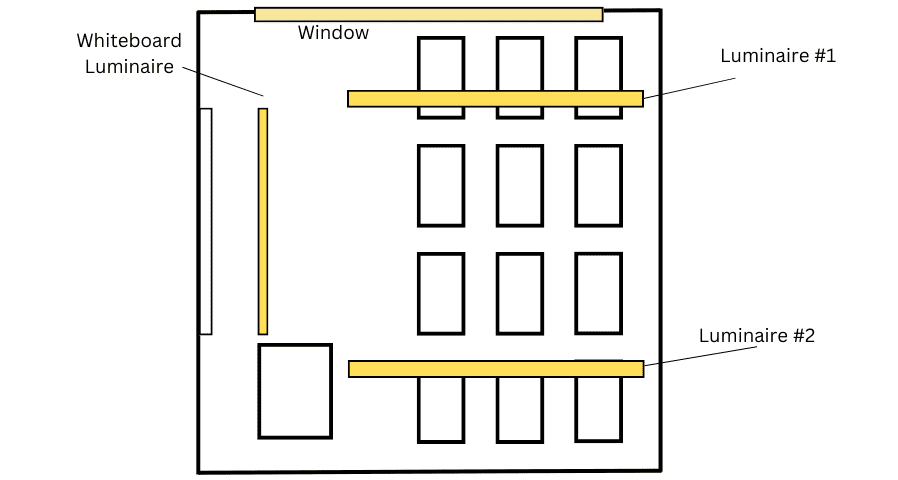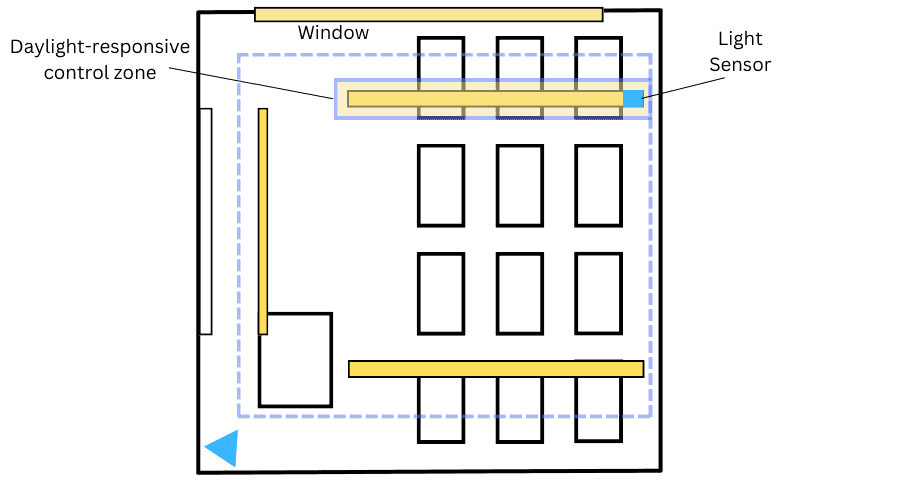Energy codes for commercial buildings contain mandatory lighting control requirements for K-12 schools. Along with high-performance requirements, flexibility is also mandated for school lighting designs. Using the various lighting control strategies outlined in this guide, schools can reduce operating costs, meet energy code compliance standards, and support a design that encourages high performance from students and faculty.
Lighting Controls for Classrooms – Three Strategies
Manual Controls
The Lawrence Berkeley National Laboratory (LBNL) estimates manual lighting controls can produce energy savings of 31 to 36%. Manual controls allow users to reduce, turn on, or turn lights to meet various visual needs. The flexibility manual controls provide can increase satisfaction by adjusting the light levels.
Occupancy Sensing
Occupancy sensors can provide energy savings of around 24%. The sensors automatically turn the lights off when a room is unoccupied.
Daylight-responsive Controls
Producing average energy savings of around 28%, daylight-responsive controls adjust brightness levels or turn the lights off in response to the amount of natural light in the room. The controls ensure the light is bright enough for tasks while also taking advantage of natural light.
Creating a High-Performance Classroom
Teaching methods and tools are constantly advancing. It includes the use of tablets, smart boards, A/V systems, and web-based learning. These tools are transforming the classroom. Teachers also need easy-to-use and easily accessible lighting controls to create the optimal environment for learning.
The Collaborative for High-Performance Schools (CHPS), founded in 1999, uses a point-based rating and recognition system to promote the construction of green schools, and updated information in 2014 includes guidance on maximizing electric lighting performance using flexible lighting controls.
Some of the guidance includes equipping classrooms with indirect and direct lighting outfitted with automated and manual controls. Whiteboards should use general or dedicated luminaires. Teachers should also have convenient access to lighting controls, along with manual override capabilities to override the time delays on occupancy sensors.
A Look at Energy Codes for Classrooms
Building energy codes are based on either ASHRAE/IES 90.1-2010 guidelines or The International Energy Conservation Code (IECC) 2012 or 2015.
The codes require classroom lighting to be turned off when the room is empty. Occupancy sensors are required in most classrooms. The sensor can be either manual or automatic. Manual switches must be conveniently located and easily accessible. Classrooms receiving ample natural light must also use daylight-responsive controls that function separately from the rest of the room’s lighting system.
Dimmer switches are permitted when the lighting design follows IECC-2012 guidelines. However, the controller must be capable of dimming the lights in stages or continuously according to need.
Here’s an example based on compliance with ASHRAE/IES 90.1-2010 and IECC 2012 guidelines.
Sample Classroom
- Space: 30 ft. x 30 ft.
- Ceiling height: 10 ft.
- Daylight: 20 ft. of windows along one wall, 8 ft. window height (floor to top of glazing)
The luminaires include indirect and direct pendant lights. Dedicated luminaires for the whiteboard are also installed in the sample classroom. LED pendant lights with continuous dimming controls are used. The luminaires are on separate ballasts to maximize control.

Occupancy Sensing Controls
The controls should automatically turn lights off when the room is not in use. The sensor can automatically or manually turn lights on when the room is in use. The guidance includes the sensors set to automatically turn lights off within 30 minutes of the last occupant leaving the room to reduce energy usage by 50% or higher.
Suggested placement options for occupancy sensing controls include installing the sensor close to the teacher’s desk. Dual-technology sensors are recommended to reduce potential interference from items like hanging objects from the ceiling. A manual override switch is also recommended.

If your school system is considering a lighting controls installation or upgrade, Action Services Group is here to help. As a product natural turn-key project management company that also offers rebate recovery services, our experts can offer guidance and management, every step of the way. Schedule a call that fits your need today!
Automatic Daylight-Responsive Controls (Side lighting)
The controls reduce lighting levels to match the amount of natural light in the classroom from the windows. The control automatically increases or decreases brightness levels accordingly.
The input follows guidelines in the IECC 2012.
Output is as follows,
- Bi-level or step-dimming switches are controlled by the light sensor. Reducing light brightness can reduce energy usage by 36% or higher. When natural light levels are bright enough for tasks, the sensors turn the lights off resulting in energy savings between 50 to 70%.
- Automatic dimming controls to reduce energy consumption by 35% or higher.
Suggested placement for automatic daylight-responsive controls is often flexible but there are some best practices to follow for best results.
- A sensor placed close to a window
- Sensors should be at least 3 feet off of the floor and installed 1 – 2 x the height of the window.
- The sensor should not be aimed to receive direct sunlight
- Do not aim the sensor over a desk
- The sensors can be mounted on an existing luminaire

Daylight-Responsive Control (Top lighting)
Controls to reduce lighting in areas where ample daylight is available. Daylight-responsive controls automatically increase or decrease the level of light to match incoming sunlight.
The input should match the guidelines in the IECC-2012.
Output is as follows,
- Bi-level or step-dimming switch to control the lighting sensor. Step-dimming can reduce energy usage by 35% or higher. In the Off position, lighting usage can decrease between 50 to 70%.
- Continuous dimming to further reduce energy usage.
The recommended threshold is,
- Daylight contribution is 150-200% of the light level for switching; but should also allow for “dead band” with high and low set-points to avoid overly frequent switching
- Daylight contribution is 150% of the light level for continuous dimming
The suggested placement for the controls includes mounting the sensor in a skylight, however, it should not receive direct sunlight.

Manual Controls
Manual controls allow users to override automatic switches. It can include on and off, along with bi-level switches.
The sequence of the control’s operation is as follows,
- The occupant uses the light switch upon entering the room
- Leaves lights at the preset brightness level or turns to full output when the occupancy sensor is automatic.
- The teacher uses a wall control sensor to select the whiteboard luminaire or select general or A/V mode.
- Overrides the time delay on the sensor as needed

Let Us Help You Control Your Classroom Lighting
While complying with energy codes and reducing electrical costs are common goals for K-12 schools, adequate lighting in the classroom is another consideration. Whether your school is creating a new lighting design or you have questions about lighting controls for the classroom, Action Services Group can help.
Contact us today to learn more by calling 610-558-9773, emailing [email protected], or schedule a call that fits your needs by clicking the button below.







































0 Comments